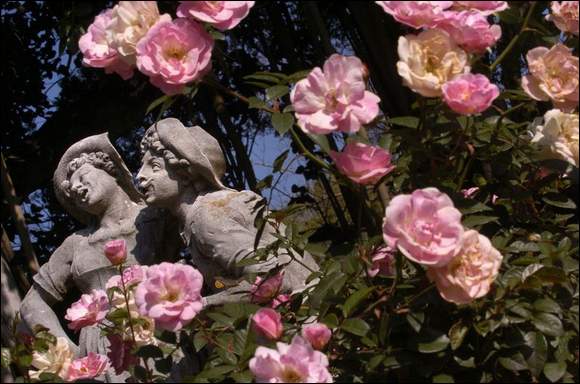At Ringling event, they promise you a rose garden
Would a rose by any other name smell as sweet? Shakespearean scholars
would probably say yes if the flower in question were called Audrey Hepburn, Honey Bouquet
or Love Potion. Experience these voluptuous blooms, along with Ingrid Bergman, Marco Polo,
Marilyn Monroe and hundreds more, when the Bradenton-Sarasota Rose Society welcomes
visitors to the 49th Annual Rose Show at the John and Mable Ringling Museum of Art next
Saturday.
The day includes a rose lecture, a book signing, guided tours, chats with experts and
exhibitors from all over the Southeast, a rose competition with judges from the American
Rose Society, and a sale of cut roses and rose bushes. The all-day public event is hosted
by Philip Paul, president of the Bradenton-Sarasota Rose Society, and Ron Mallory,
vice president of that organization and curator of Mable Ringling's rose garden at the
museum.

Admission to the rose show is included in a general admission ticket ($15)
to the museum, which includes the rose show, the art museum, the Ringling residence (C
d'Zan), the circus museum and all special exhibitions.
The Bradenton-Sarasota Rose Society is a non-profit educational organization that is a
local resource for rose growers. The group holds monthly meetings (except in July and
August), and organizes rose-growing workshops for members at all levels of expertise.
Mable Ringling's garden boasts 1,200 rose plants, and is the only
All-America Rose Selection (AARS), American Rose Society Award of Excellence (AOE), and
Mini Rose Test Garden in Florida. It is one of only three AARS public display gardens in
Florida.
The rose was Mable Ringling's favorite flower. She planted her garden in 1913 (a dozen
years before her marble mansion was built), laying it out in the shape of a wagon wheel.
She favored the China, Tea and Polyanthus varieties. None of her bushes survive today, but
many of the rose varieties she tended are again in the garden.
Rose expert Ron Mallory is in charge of the 27,225-square-foot garden,
which is ornamented with classical statuary, architectural elements, and a picturesque
limestone gazebo that is original to the garden. The gazebo is the favorite site for
garden weddings of about 50 guests.
Mallory, who has been with the Ringling Museum for 20 years and will retire in June, spent
five years experimenting with cross breeding until he came up with a rose he named for
Mable Ringling and officially registered with the American Rose Society in 2002. It's a
feminine, deep-pink floribunda, whose father (pollen) is the yellow Midas Touch and whose
mother (seed) is the red Proud Land.
"I started with hundreds of seeds, and over the years, came to develop this special
rose," he said. "It's a short, medium-sized rose that is disease-resistant and
has a lovely fragrance. Each rose has 60 petals and the bud is vibrant red. It opens to a
magenta color with a dark yellow stamen. It's in bloom now, and visitors to the show will
have a chance to see it."
Mallory is working on another original rose named for his grandmother Allison, who taught
him about rose growing in the 1950s.
In addition to those special flowers, Mallory oversees the care of eight tree roses, 36
grandifloras, 64 shrubs, 73 old garden roses, 204 floribundas, 246 hybrid teas and 506
miniatures. Most of these roses were planted as part of an extensive restoration project
of museum buildings and grounds undertaken in 1991.
Mallory revealed his favorite roses in the Ringling garden. "It depends upon the time
of year," he said, "but I'm especially fond of Just Joey, a large,
apricot-colored hybrid tea; the red Veteran's Honor; White Success, which has wonderful
form and a long stem; and Our Lady of Guadalupe, which is a pink floribunda."
Mallory's tips for successful rose growing? "It's a balance of water, fertilizer and
sanitation," he said. "And, in general, roses need six hours of sunshine a day.
For the beginner, I suggest Knock Out, a shrub rose that is hardy and lovely. We have a
border of these dark pink roses on either side of the path leading into Mable's
garden."
Roses in this part of Florida usually bloom from early April through mid-December. Mallory
starts pruning the museum bushes in late January.
Just beyond Mable's rose garden are two test rose gardens. Rose entries in a national test
garden undergo a rigorous, two-year evaluation period. The roses having the highest scores
receive the prestigious AARS award. There are only two-dozen AARS test gardens in the
United States.
The Ringling Museum property is 66 acres; recently, as part of a spring spruce-up, staff
and volunteers installed 200 new trees, 40,000 new plantings and laid 700 yards of mulch.
That translates to more than 6,000, three-cubic-foot bags. About three-dozen community
volunteers helped dig the holes, plant the foliage and spread the mulch. Now the public is
invited to inspect and enjoy John and Mable Ringling's spectacular back yard.
Sarasota Herald-Tribune: April 07. 2007
More Information like the above.